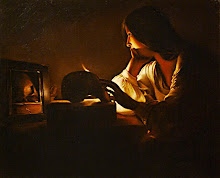"Brush with Fate", by Brent Shields, DVD 2004, Metrodome Distribution
“Brush with Fate” (2003), written by Richard Russo, is the movie adaptation of Susan Vreeland's novel, “Girl in Hyacinth Blue”. Starring Thomas Gibson, Glenn Close, Ellen Burstyn and Phyllida Law, “Brush with Fate”, is a what-if art history and Vermeer trivia that never really succeeded in moving its audience. Despite the intriguing storyline – a "lost" Vermeer painting ended up into the hands of a European history teacher at a tony American college, and the stories of its previous owners – there is something missing here. Let us take a closer look at what is missing.
First, the movie starts with a hypothesis: what if a lost Vermeer painting had been found, changed hands through centuries, and finally ended up into the hands of Cornelia Engelbrecht (Glenn Glose, impeccably creepy), whose father was a former Nazi officer stationed in the Netherlands during WWII? At that point, there are two possible ways of telling the story: 1/ The lost Vermeer painting is the story, which means, director Brent Shields should had focused more on what makes a Vermeer a Vermeer, and why and/or how, its uniqueness might have affected people's lives 2/ The lost Vermeer painting is merely the background of another story, that of the “People who have been, for one brief moment of time, the owners of a genuine lost Vermeer” (Cornelia Engelbrecht). The trouble is, “Brush with Fate”, never really chose which hypothesis its story was based on. Yet, the result is not entirely without merit, as it provides with moments of pure beauty. However, these moments could have been caused by many other things, not necessarily related to a Vermeer painting, real or imaginary.
There are additional puzzling questions that are not properly addressed in the movie. First, why “Brush with Fate”? Whereas the original title, “Girl in Hyacinth Blue”, makes much more sense, as it is the subject matter of the “lost” Vermeer painting. Second, why Cornelia Engelbrecht, a female European history teacher, and not Cornelius Engelbrecht, a male math teacher, as it was in the novel? But most puzzling of all questions, why Cornelia Engelbrecht suddenly decided to show the painting to Richard (Thomas Gibson), an art teacher she just met at her college? In addition to these questions, “Brush with Fate”, is a made-for-television movie – originally, a Hallmark Hall of Fame production – which means the visual quality is not completely at the same level as the painting's beauty, it is supposed to celebrate.
Even, if the painting is always filmed in the best possible light, I found it difficult to really marvel at it, or even to feel overwhelmed by it. Having written that, I wanted to pay tribute to Jonathan Janson, the painter who created the “lost” Vermeer, for this movie. Although, art connoisseurs would never mistake his “Girl in Hyacinth Blue” with a genuine Vermeer, lost or not, his work was good enough – a beguiling imitation, surely – to create an aura of mystery and fascination around it. For those who are interested in Vermeer, I therefore, strongly recommend a visit to Jonathan Janson's website at: www.essentialvermeer.com
Is “Brush with Fate” a good movie? Yes and no. Yes, because it has an original story, a good acting – especially by the Dutch cast – and it was shot in situ, which gave the movie the proper atmosphere. Also, “Brush with Fate”, introduces its audience to the essential question for all art experts, that of an artwork's provenance. Finally, the movie leaves the viewer wondering if beauty can move even the most tainted souls. No, because, it never clearly chose which hypothesis its storyline was based on. Also, it is lacking in visual power, especially around the question of what constitutes the painting's very uniqueness. With its emphasis on the importance of beauty in human life, I would have expected “Brush with Fate”, to disclose more of it.
Why the people in the frame - the ones whose lives revoveld around the “lost” Vermeer painting - have been so deeply affected by it? Perhaps, part of the answer to that question might be found in Susan Vreeland's novel, when in the last tale of her book, “Magdalena Looking”, Vreeland wrote: “Almost a child she was, it seemed to her, gazing out the window instead of doing her mending, as if by the mere act of looking she could send her spirit out into the world”, (p239). A final practical word: the 2004 DVD edition has no extra features whatsoever, not even subtittles, but saddest of all, no Vermeer gallery or biography.What a miss!












